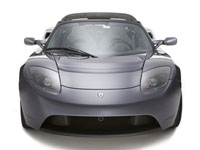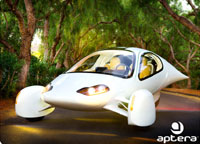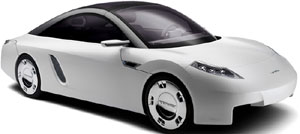$10 million X PRIZE for the best, fuel-efficient car on the planet
07 Apr 2008
The announcement
A major step in the journey towards a greener, cleaner automobile was the announcement of the $10 million Progressive Insurance Automotive X PRIZE at the New York International Auto Show.
This race, which already has 60 competitors from nine countries signed up, is not to build the fastest vehicle on the planet, but rather the most fuel-efficient.
The stakeholders
The competition is being administered by the X PRIZE Foundation, which is a non-profit prize institute that ''creates and manages prizes that drive innovators to solve some of the greatest challenges facing the world today''. They have already instituted major awards in the pioneering fields of genomics and space travel, and have now extended their support to the automotive arena by creating the Automotive X PRIZE with the stated goal ''to inspire a new generation of viable, super-efficient vehicles to help break our addiction to oil and stem the effects of climate change''.
In this endeavour, it is ably supported by the prize sponsor Progressive Casualty Insurance Co., the third-largest auto insurer in the US. In a statement, Glenn Renwick, Progressive Insurance's president and chief executive officer, justified their association with the award citing their own history of striving to make constructive changes in the auto and auto insurance industry.
''We've been working hard to make a difference in car insurance for 70 years. Now we have a chance to make a difference by supporting the Progressive Automotive X PRIZE. This will result in more choices of more fuel-efficient vehicles for drivers and will be a catalyst for moving this technology forward faster'', he said, adding that being a part of this momentous event provides them a real chance of making a real difference.
The history
The foundation of the X PRIZE foundation lies in the Oertig Prize of 1919 that revolutionized the field of aviation. This was a $25,000 purse offered by hotel magnate Raymond Orteig to the first person to fly non-stop between New York and Paris. Eight years later, Charles Lindbergh succeeded when he flew his small airplane, Spirit of St. Louis, across the Atlantic Ocean and became the most famous man on Earth, and Time's first ''Man of the Year''.
But before Lindbergh's success, there were eight failures, or rather, partial successes, for it was those efforts which collectively led to the success of the Spirit of St. Louis Organization and stimulated the advancement of aircraft technology, making the 20th century the age of aviation.
As the foundation says on its website, ''these nine teams cumulatively spent $400,000 to win the $25,000 purse - and spawned today's $250 billion aviation industry''.
The Oertig Prize was a tremendous initiative in an era of government apathy, and without the promise of tangible financial returns, and the results were visible for all to see. The X PRIZE Foundation had its origin in this story of the Oertig Prize and Lindbergh's triumph almost a century ago.
The dream
After the Earth's skies had been conquered, the logical next step was to soar beyond into interplanetary space.
However, space travel remained frightfully expensive and confined to the domains of governmental space organizations that could rustle up the enormous quantities of money required for such endeavours. In such a situation, Dr Peter H Diamandis, the brain behind the foundation, came across a copy of The Spirit of St. Louis written by Charles Lindbergh himself.
Going through this account of an incredible man's incredible experiences, Dr Diamandis realised that his lifelong dream of travelling into space could be made a reality through the creation of a prize similar to the one Lindbergh was awarded for crossing the Atlantic in an aircraft. Lindbergh and his organization had been amateurs, but had yet been able to best large government-style efforts by dint of their perseverance and ingenuity.
The recent past
Dr Diamandis was of the firm belief that such an experience can be repeated, with space being the new frontier. As a result, the X PRIZE Foundation came into being in 1995, with the assistance of Byron K Lichtenberg, Colette M Bevis and Gregg E Maryniak, the last-named being the person who had introduced Dr Diamandis to The Spirit of St. Louis.
Life came full circle when the St. Louis community provided additional seed funding to organize the foundation and became the first headquarters of the X PRIZE Foundation in 1996. On 18th May 1996, under the Arch in St. Louis, in front of a crowd of television cameras, reporters and proud onlookers, the creation of the X PRIZE competition was announced. The occasion was graced by the presence of Erik and Morgan Lindbergh, Charles Lindbergh's grandchildren. Erik Lindbergh is an existing member of the foundation's board of trustees.
The prize
The X PRIZE was renamed the Ansari X PRIZE on May 6, 2004 following a multi-million dollar donation from entrepreneurs Anousheh Ansari and Amir Ansari. Anousheh Ansari, is the Iranian-American co-founder and chairman of Prodea Systems, Inc., and recently became the first woman space tourist when she flew on a Russian space module to the International Space Station on 18th September 2006.
The prize offered $10 million prize for the first non-government organization to launch a reusable manned spacecraft into space twice within two weeks, with space being defined as beginning at an altitude of 100 km above the earth's surface. This goal was selected to help encourage the space industry in the private sector, which is why the entries were not allowed to have any government funding. It aimed to demonstrate that space flight could be affordable and accessible to corporations and civilians, opening the door to commercial space flight and space tourism.
The results
The prize was won on 4 October 2004, the 47th anniversary of the launch of the first man-made satellite in space, Sputnik, by the Tier One project designed by Burt Rutan and financed by Microsoft co-founder Paul Allen, using the experimental space plane SpaceShipOne.
However, the real winner was space travel in general, for the prize had encouraged the investment of at least $100 million in related technologies.
The results, again, are there for all to see. From being confined to images of space shuttles beamed on television, space travel has permeated to everyday conversation, with a distinct possibility of becoming a part of everyday life in the near future. Already, sunrise entrepreneurs like Sir Richard Branson of Virgin Group and Jeff Bezos of Amazon have declared their plans of offering space travel on a commercial basis.
The present
After space, the foundation has redirected its efforts towards terra firma and come up with the Automotive X PRIZE. This prize is offering $10 million to the teams that can produce the most production-ready vehicles that return 100 miles per gallon (161 kilometres in 3.84 litres) of gasoline or more.
The prize has been divided into two categories – mainstream and alternative vehicles.
Mainstream cars must carry four or more passengers and have climate control, an audio system and 10 cubic feet of cargo space. They also must have four or more wheels, be able to accelerate to 60 miles per hour (96 kilometres per hour) in less than 12 seconds and have a minimum top speed of 100 miles (161 kilometres) per hour over a range of 200 miles (322 kilometres).
Alternative vehicles will be required to carry two or more passengers and five cubic feet of cargo, have a top speed of at least 80 miles per hour (128 kilometres per hour) and have a range of at least 100 miles (161 kilometres).
Entrants will have to prove their mettle during a series of races in 2009 and 2010 that will test speed, distance, urban driving and overall performance. The detailed rules are still being framed.
The contenders
More than 60 teams from nine countries have already signed the letter of intent with the foundation. These include notable names like Aptera Motors and Tesla Motors from California, Loremo from Germany as well as a team from the famous Cornell University. More teams are expected to sign up with applications allowed till mid-2008.
Tesla Motors
 Tesla Motors, named after the famous erstwhile pioneer in the field of electricity Nikola Tesla, is a Silicon Valley auto mobile start-up company focusing on the production of high performance, consumer-oriented electric vehicles. Started in 2003 by engineers Martin Eberhard and Marc Tarpenning in San Carlos, it has since grown into a force to reckon with in the field of electrical vehicles, and recently unveiled its first production vehicle, the Tesla Roadster.
Tesla Motors, named after the famous erstwhile pioneer in the field of electricity Nikola Tesla, is a Silicon Valley auto mobile start-up company focusing on the production of high performance, consumer-oriented electric vehicles. Started in 2003 by engineers Martin Eberhard and Marc Tarpenning in San Carlos, it has since grown into a force to reckon with in the field of electrical vehicles, and recently unveiled its first production vehicle, the Tesla Roadster.
Aptera Motors
 Aptera Motors (formerly Accelerated Composites) is a maker of high-efficiency vehicles also based in California. Its first product, a three-wheeled two-seater resembling a small air plane, is currently under development, although it has received several orders even before production. The hybrid petrol-electric vehicle is expected to deliver an amazing 230 miles per gallon on a fully charged battery.
Aptera Motors (formerly Accelerated Composites) is a maker of high-efficiency vehicles also based in California. Its first product, a three-wheeled two-seater resembling a small air plane, is currently under development, although it has received several orders even before production. The hybrid petrol-electric vehicle is expected to deliver an amazing 230 miles per gallon on a fully charged battery.
Loremo AG
 Loremo AG is a Munich-based auto maker, and is focused on designing and manufacturing cars with very low weight and air resistance. ''Loremo'' is actually an abbreviation of Low Resistance Mobile. Founded in 2000, it has considered India as one of the earliest markets for its extremely fuel-efficient car that is expected to go under production soon.
Loremo AG is a Munich-based auto maker, and is focused on designing and manufacturing cars with very low weight and air resistance. ''Loremo'' is actually an abbreviation of Low Resistance Mobile. Founded in 2000, it has considered India as one of the earliest markets for its extremely fuel-efficient car that is expected to go under production soon. The Conclusion
We have featured only a few among the illustrious list of competitors. With the announcement of this massive amount as prize money, one can be confident that bigger names will also join the fray. If the success of Lindbergh's Atlantic crossing or the achievement of Rutan's foray into the fringes of unknown space can be replicated, it would be money well spent. For space may still be a little far away, but we can always do with thriftier cars and a less polluted environment.
View: Auto videos | Auto picture galleries






















